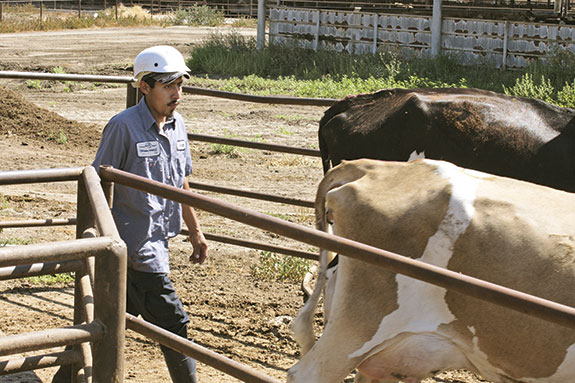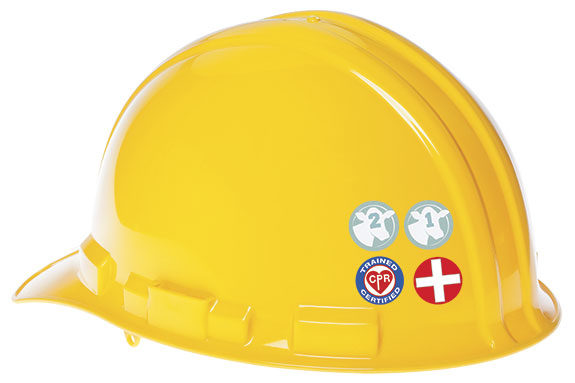Step into a cow pen on Charles Ahlem Ranch in Hilmar, California, and you better make sure you have a hard hat on. The dairy-issued headgear is required equipment for all employees bringing cows up an alley to the parlor or helping with a vet check.
The dairy’s herd manager, Frank Dinis, says he hopes to further encourage the hard-hat policy in the future by rewarding employees who complete the dairy’s cattle handling, first aid and other employee trainings with stickers to add to their helmets.
Charles Ahlem Ranch milks 6,000 cows on five dairies and has been using Merck Animal Health’s Dairy Care365 program since it was introduced last year to teach proper cattle-handling techniques.
That program uses video modules to educate participants how to effectively manage and handle dairy cattle in a low-stress manner. Dr. Mike Bolton, the technical service veterinarian for the company who coordinated the development of the materials, says the training applies to dairies of all sizes.
“This is one of those things that transcends the size of your dairy – this is for small and large dairies,” Bolton says.
How it all came about
Merck Animal Health partnered with Dr. Paul Rapnicki, a former clinical professor with the University of Minnesota’s College of Veterinary Medicine, to produce the video training modules in English and Spanish. They released the second installment in the educational series this summer.
The newest module discusses how to calmly and efficiently move cows out of their pen, to a holding area, into the parlor and then back to their home pens after milking.
“This module recaps the first introductory video and then works into describing how to improve the conditions pertaining to the cow’s employment,” Bolton says.
“What cows have to do three times a day is leave a nice, sandy beach-like pen with water and feed and go to a crowded area and work there three times a day for an hour each time. … This video explains how to move those cattle in a quiet, gentle manner so that when they actually get to work in the parlor, they feel like going to work and produce milk.”
In the module, participants watch 20 minutes of narrated video explaining low-stress cattle-handling techniques. A quiz at the end of the session tests participants’ knowledge by reading them five questions and the potential answers about the videos they’ve just watched.
A participant must correctly answer at least four of the questions to pass. The employee can then print a certificate of completion after passing the quiz.
“We see the modules as a wayfor employees to learn how to readthe cowsand be aware thattheir actions will affect the cow,” Dinis says.
“We want employees to be aware that the failure of the cow to do what we need her to do may be because the employee didn’t handle her correctly, and not because the cow is stupid or crazy. If employees realize what their actions are causing the cow to do, then we can train anyone to be a good cow person.”
Bolton says the modules’ method to evaluate the effectiveness of the training provided is one of its greatest strengths.
“We constructed these in such a way that even the assessment is narrated and guided by a traveling arrow so that the person watching can be illiterate and still know what the question being asked is and where each of the potential answers are located on the screen because someone is reading it to him or her,” he says.
The training can be obtained through Merck Animal Health on CD/DVD or on a USB drive that plays on any Windows-operated desktop or laptop computer.
(Be advised that the system requires Flash 6.0 or better. This is available on most newer computers. To write this article, the author attempted to watch the videos on a PC desktop that would compare to some “barn” computers in age and speed. It was not equipped to run the program and required the latest software updates to be downloaded. The training will not run on Mac computers.)
“I think it’s really easy to make protocols or go to a lot of meetings to hear people talk about how animals should be handled, but to actually break it down into a module like this where it gives some tips about how to handle animals, that’s where we can really impact the welfare of individual animals,” Bolton says.
Training leads to savings
Bolton says the modules have the potential to directly impact a dairy’s finances by lowering injury-related costs and encouraging more milk production due to increased cow contentment during transit and more milk letdown in the parlor.
Dinis says using the training modules have helped cut the worker compensation claims on his employer’s operations in half.
And the hard hats have helped too, preventing at least one potentially serious injury. Dinis says the dairy believes the hard hats will prevent future injuries as well.

The hard-hat rule began as a mandatory one for just cow pushers.
It was intended to eliminate one worker’s excuse for missing shift time because he occasionally claimed he had headaches from hitting his head on rails while ducking in and out of pens to fetch cows.
Dinis says he knows wearing a hard hat likely saved the life of a female cow pusher recently.
After her concussion from a slip and fall backward onto a concrete alley, the dairy decided hard hats would be mandatory for all employees working in a pen, not just cow pushers.
More video modules coming
Bolton says he hopes more veterinarians will get involved in using the video modules to help their clients train employees.
“There are quite a few veterinarians that are fluent in Spanish. They just needed a tool,” Bolton says. “Many of them have been using these modules to train employees on the farm.”
In the future, the company plans to release more videos on proper handling of lame cows, care for special-needs cows, euthanasia and calf care. These more specialized videos will be especially useful to vets, Bolton says. However, he says these first two on dairy stockmanship will be the most universally applicable.
“The fact these modules have resonated well in other countries where English is not the first language, shows [stockmanship] is important everywhere,” Bolton says. PD
PHOTO
An employee at Charles Ahlem Ranch in Hilmar, California, pushes cows toward the parlor. All of the dairy’s employees are required to wear hard hats when working in pens and alleys. Photo by Ray Merritt and photo illustration by Philip Warren.

Walt Cooley
Editor
Progressive Dairyman







